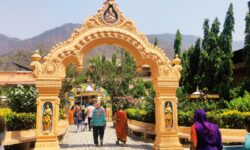Introduction to Kerala Tourism
Kerala Tourism stands apart for its balance between calm nature and vibrant life. Sitting on India’s southwestern coast, this state offers something that very few destinations manage to achieve—an authentic connection between people, land, and tradition. It’s not just about beaches or hills; it’s about how every part of Kerala feels alive with history, natural beauty, and warmth.
Whether you’re standing beside the coconut-fringed backwaters or walking through the spice gardens of Wayanad, Kerala gives you reasons to pause. And those pauses stay with you long after the journey ends.
Calm Waters and Backwater Stays
The backwaters of Kerala are a central part of its tourism. These still, winding water channels stretch through towns, villages, and paddy fields. Most visitors are drawn to Alleppey and Kumarakom, where houseboat stays are more than just a travel experience—they feel like a piece of daily life.
These houseboats, traditionally called “kettuvallams,” are built from wood and coir. They move slowly along the water, giving you time to take in the scenery. You can hear temple bells in the distance or spot a fisherman casting his net. For those looking for a quiet moment, this is Kerala Tourism at its most peaceful.
Many homestays and resorts along these waters also give visitors a deeper insight into life in Kerala. It’s not just sightseeing; it’s observation and participation.
Hills, Tea Gardens, and Forest Trails
Away from the backwaters, Kerala’s hills call out with a different kind of charm. Munnar, Thekkady, and Wayanad form a trio of green-covered hill stations known for their tea plantations, forest treks, and biodiversity.
Munnar is known for its endless tea gardens. When mist floats across those green hills, you understand why this region has long inspired writers and travelers alike. Many tea estates also offer guided walks where visitors can learn how tea is grown, picked, and processed.
In Thekkady, Kerala Tourism becomes about raw nature. The Periyar Wildlife Sanctuary here is one of the best-managed forest reserves in India. It offers boating through lake waters, border hiking, and bamboo rafting. Wayanad is where forests and heritage meet—home to ancient caves, waterfalls, and tribal communities.
These hilly parts of Kerala give a different dimension to tourism—not just visual appeal but quiet learning and reflection.
Beaches That Still Feel Local
Kerala Tourism is often associated with beaches, but they are not overbuilt or noisy like other coastal states. Places like Varkala and Kovalam are known, but they still hold on to their roots.
Varkala stands out because of its natural cliffs that look down onto the sea. Local eateries line the cliff edge, serving simple food that complements the mood. The beach has religious significance too—Papanasam Beach is believed to wash away sins.
Kovalam, once a fishing village, now has small resorts and Ayurvedic centers along its shore. Even with visitors around, mornings still belong to the fishermen who pull their boats ashore. There’s a mix of quiet routines and relaxed visitors, and that balance defines the place.
Smaller beaches like Marari, Bekal, and Payyambalam also offer scenic comfort, often with fewer crowds. These places remind visitors that Kerala Tourism doesn’t try to impress—it lets nature do the talking.
Culture, Festivals, and Local Art
What makes Kerala stand out in Indian tourism is how culture isn’t packaged for tourists—it’s lived and shared. From traditional Kathakali performances to temple festivals with giant decorated elephants, everything feels real.
Onam, the harvest festival, is celebrated across Kerala with colorful flower arrangements, boat races, and traditional meals served on banana leaves. It’s one of the most engaging times to experience Kerala Tourism, especially for those who enjoy seeing community life up close.
Kathakali and Mohiniyattam are not just dance forms; they’re performances that require years of discipline. Many centers across the state, especially in Kochi and Thrissur, allow visitors to watch these performances in intimate settings.
Theyam, another ritualistic art form performed in northern districts like Kannur, is a powerful experience. It’s not entertainment—it’s a deep cultural expression passed through generations.
Food That Reflects Soil and Tradition
Kerala’s cuisine mirrors its landscape—coastal, green, and full of flavor. Rice, coconut, and a range of spices define most dishes. Whether it’s a simple vegetable thoran or a spicy fish curry, the food connects you with the land.
In central Kerala, toddy shops serve freshly tapped palm wine along with spicy, earthy food. In the Malabar region, the biryanis are rich and full of local spices. Syrian Christian dishes in Kottayam and Kumarakom, especially duck roast and fish molly, offer different layers to Kerala Tourism through taste.
The traditional Kerala sadya—a vegetarian feast served during festivals—is a sensory journey in itself. Served on banana leaves, it contains more than 20 items, each with a different flavor and purpose. Tourists who enjoy food not just as a dish but as part of a story will find plenty here.
Ayurveda and Wellness Traditions
Kerala is known globally as a center for Ayurveda. Unlike commercial wellness routines, Ayurvedic treatment here is rooted in the medical traditions of the state. Kerala Tourism includes this side of travel too—especially in places like Palakkad, Malappuram, and Thiruvananthapuram.
Authentic Ayurveda centers offer treatments for back pain, stress, arthritis, and lifestyle-related conditions. These are not just spa treatments but guided healing plans. Many wellness resorts include diet, yoga, and meditation as part of the process.
This ancient healing science adds depth to tourism in Kerala. It invites visitors not just to relax but to restore and rebalance.
Towns with Timeless Stories
Cities like Kochi, Thrissur, and Thiruvananthapuram are not just transit points—they’re full of stories. Fort Kochi, with its Chinese fishing nets, old churches, and Jewish synagogues, is a lesson in shared histories. Walk down the narrow lanes and you’ll find spice warehouses, art cafes, and murals that speak of trade, travel, and tradition.
Thrissur, the cultural capital, is known for its grand Pooram festival, but also for its museums, temples, and music schools. In Thiruvananthapuram, you’ll find a mix of palaces, beaches, and temples, with the added grace of old-school charm.
These urban parts of Kerala Tourism are still deeply rooted. They’re not rushed or chaotic. Instead, they encourage slow walks, patient listening, and respect for the place.
Responsible Travel and Natural Balance
One of the quiet strengths of Kerala Tourism is how it leans toward sustainability. Several eco-tourism initiatives across the state work closely with local communities and natural reserves. Places like Thenmala and Gavi offer eco-lodges, guided forest walks, and educational experiences that connect travelers to conservation efforts.
The tourism department also promotes homestays and community-based travel where visitors stay with families, learn local crafts, and eat home-cooked food. This approach helps protect cultural identity and ensures tourism benefits reach smaller villages and local artisans.
For those who value responsible travel, Kerala offers real choices—where tourism doesn’t harm but instead becomes a tool for balance.
Final Thoughts
Kerala Tourism isn’t about overstatement. It doesn’t try to impress in the obvious ways. What it offers is depth—a connection between people, culture, food, and the land. Whether you come for a short stay or a long retreat, you leave with a different rhythm in your step.
The state respects its roots while gently welcoming travelers to join the rhythm of its everyday life. That’s the quiet strength of Kerala. It stays with you. It doesn’t shout. It simply exists—and that makes all the difference.







